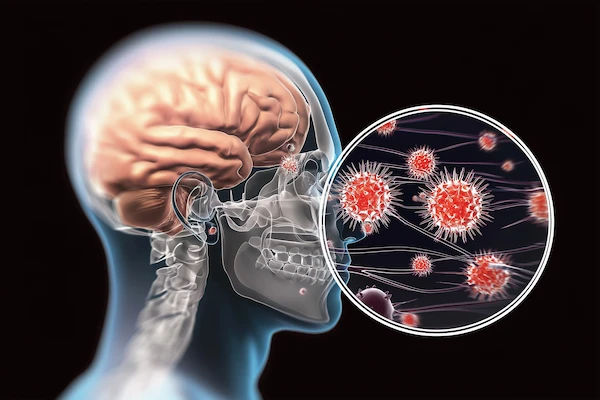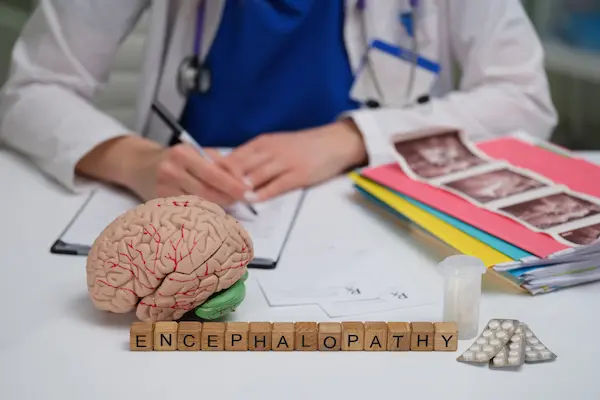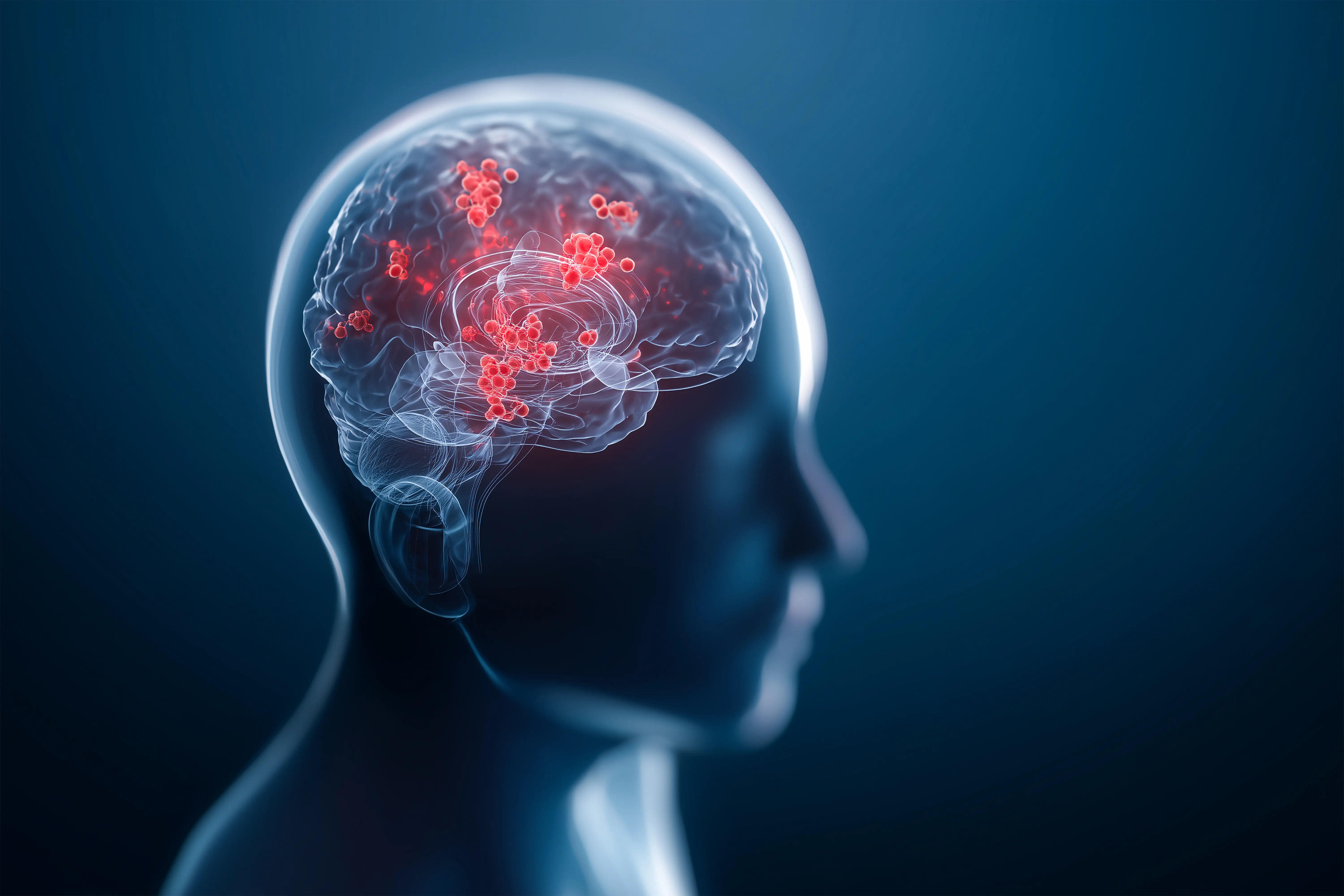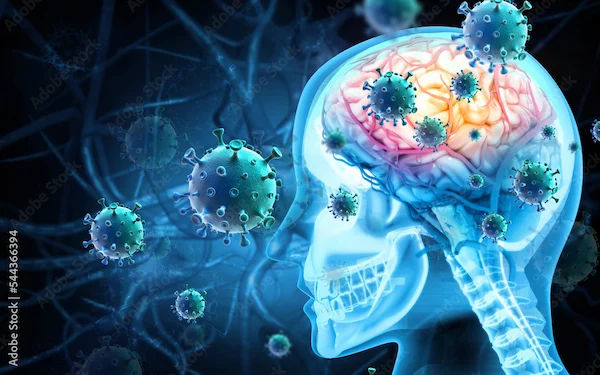Acute Encephalitis Syndrome (AES) A Complete Guide
Learn about Acute Encephalitis Syndrome (AES) including causes, symptoms, diagnosis, treatment, recovery, prevention, and outbreak lessons in India. Recognise red flags and protect your family.

Written by Dr. Siri Nallapu
Reviewed by Dr. Rohinipriyanka Pondugula MBBS
Last updated on 25th Oct, 2025
%20A%20Complete%20Guide.webp?tr=q-80,f-webp,w-350,dpr-2,c-at_max 700w)
Introduction
Acute Encephalitis Syndrome (AES) is a medical emergency. It starts suddenly with high fever and brain inflammation, and can quickly progress to seizures, confusion, or coma—especially in children. AES is a “syndrome,” meaning it’s a cluster of symptoms with many possible causes, from viruses (like Japanese encephalitis) to bacteria, parasites, toxins, or severe metabolic problems. In parts of South Asia, AES often spikes during the hot, rainy months and can affect entire communities.
This guide translates medical knowledge into practical steps you can use. You’ll learn how to spot early warning signs, when to go to the hospital, what tests and treatments to expect, and how recovery and rehabilitation work. We’ll also explain prevention strategies—vaccination, mosquito control, nutrition—and what we’ve learned from real outbreaks, including lychee-linked cases in India. Wherever you live, knowing the basics of acute encephalitis syndrome can help you act fast and protect your family. If you or a loved one has high fever with severe headache, confusion, or seizures, seek emergency care immediately.
What is Acute Encephalitis Syndrome (AES)?
Here's what you need to understand about AES:
AES is a clinical diagnosis that describes patients with an acute onset of fever along with altered mental status (confusion, disorientation, coma) and/or new-onset seizures, with or without other neurological signs. It is an umbrella term—doctors use it when a person clearly has encephalitis (inflammation of brain tissue) but the exact cause is not yet known. This framework helps clinicians initiate prompt, life-saving care even before lab confirmation.
AES vs. encephalitis: What’s the difference?
• Encephalitis is brain inflammation confirmed or presumed from clinical signs and tests. AES is the broader clinical syndrome used for surveillance and early management, especially in regions with multiple potential causes (viral, bacterial, parasitic, toxic, metabolic).
• In practice, AES is often used in public health programs to track cases and respond to outbreaks, while “encephalitis” is the clinical condition addressed at the bedside.Consult Top Specialists
Where and when does AES occur?
• AES can occur anywhere, but it’s notably common in parts of Asia, including India, Nepal, Bangladesh, and Southeast Asia.
• Cases often rise during warmer, rainy seasons (monsoon), when mosquito populations increase, water stagnates, and enteric infections are more common.
Why it matters
• AES can progress rapidly and cause brain swelling, seizures, and life-threatening complications. Early recognition and treatment dramatically improve outcomes.
• Children and undernourished populations are at higher risk for severe disease and complications.
Causes and Risk Factors
Here's an overview of the main causes and risk factors:
AES has many causes; finding the culprit guides targeted treatment. However, because time is critical, doctors begin stabilising and empiric therapy while tests are pending.
Infectious causes
• Viral: Japanese encephalitis virus (JEV) is a leading cause in Asia; others include herpes simplex virus (HSV), enteroviruses, West Nile virus, and dengue.
• Bacterial: Leptospirosis, scrub typhus (Orientia tsutsugamushi), and tuberculosis can present as AES in endemic regions.
• Parasitic: Cerebral malaria (Plasmodium falciparum) and neurocysticercosis can mimic or cause AES-like presentations.
Non-infectious causes
• Toxins and metabolic disorders matter, too. In certain Indian districts, undernourished children who eat lychee fruit in the evening or on an empty stomach have developed hypoglycaemic encephalopathy due to toxins (MCPG and hypoglycin A) that block glucose production at night. Ensuring an evening meal and rapid glucose correction reduced deaths in outbreaks.
Who’s most at risk?
• Children under 15, especially those who are undernourished.
• People living in rural or peri-urban areas with poor sanitation, stagnant water, or close proximity to pig farms and rice paddies (JEV ecology).
• Communities with low vaccination coverage for Japanese encephalitis.
Seasonal and environmental drivers
• Monsoon season, high mosquito density, flooding, and warm temperatures amplify risk.
• Agricultural patterns (e.g., rice cultivation) and animal reservoirs (pigs, water birds) sustain JEV transmission.
Symptoms and Red Flags
AES typically starts with high fever and headache, often accompanied by nausea or vomiting. Within hours to days, signs of brain involvement appear. Recognising these “red flags” can save a life.
Early signs to watch for
• Sudden high fever, severe headache
• Nausea/vomiting, extreme tiredness
• Behaviour change: irritability, confusion, drowsiness
Red flags requiring emergency care
• New seizures or fits; repetitive jerking or staring spells
• Altered mental status: not recognising family, excessive sleepiness, incoherent speech, or coma
• Stiff neck, severe sensitivity to light, severe or escalating headache
• Focal neurological signs: weakness on one side, difficulty walking, slurred speech
• Signs of raised intracranial pressure: persistent vomiting, worsening headache, unequal pupils
• In children: persistent inconsolable crying, refusal to feed, sudden collapse
Lychee-linked clue
• In high-risk districts during lychee season, a child who goes to bed well and is found early morning with seizures or unconsciousness may be experiencing hypoglycaemic encephalopathy; immediate glucose can be lifesaving.
What to do immediately
• If a person has a seizure lasting more than 5 minutes, or repeated seizures, call emergency services. Place them on their side, clear the area, do not put anything in the mouth, and time the seizure.
• For any combination of high fever with confusion or seizures, go to the nearest hospital without delay. If you need advice while arranging transport, you can consult a doctor online with Apollo 24|7; however, do not postpone emergency evaluation.
Diagnosis: How Doctors Find the Cause
Here's how diagnosis works:
In the hospital, clinicians assess and support vital functions first, then work to pinpoint the aetiology. The immediate goals: stabilise the patient, exclude hypoglycaemia, and start empiric treatment for likely causes.
Clinical exam and bedside clues
• Vitals (temperature, blood pressure, oxygen), neurological exam (level of consciousness, neck stiffness, focal deficits), rash or eschar (scrub typhus), signs of mosquito exposure, hydration and nutrition status.
• Bedside glucose is critical; low blood sugar must be corrected immediately, particularly in children.
Laboratory tests
• Blood tests: complete blood count, electrolytes, liver and kidney function, malaria smear/rapid test, inflammatory markers. Depending on region: scrub typhus serology, leptospira testing.
• CSF (lumbar puncture): helps differentiate viral vs bacterial causes; PCR may detect HSV, enteroviruses, or JEV antibodies. A lumbar puncture is performed when it is safe (no signs of dangerously raised intracranial pressure on exam/imaging).
• Imaging: CT or MRI of the brain if focal deficits, seizures, or altered consciousness, to look for swelling or specific patterns (e.g., temporal lobe involvement in HSV).
• Differential diagnosis: meningitis (meningeal inflammation with or without brain involvement), cerebral malaria, heat stroke, toxin exposures, and metabolic encephalopathies.
If you’re recovering at home and need follow-up tests (for example, electrolytes or routine blood work as advised), Apollo 24|7 offers convenient home collection
tests such as complete blood count or fasting glucose. For acute symptoms, go directly to a hospital.
Treatment and Hospital Care
Here's what happens during hospital care:
Time is brain. While the exact cause is being investigated, doctors begin broadly protective treatments to reduce the risk of irreversible injury.
Stabilisation
• Airway, breathing, circulation: oxygen, IV access, fluids as needed.
• Immediate correction of hypoglycaemia (IV dextrose), especially in children with early-morning onset during lychee season.
• Control seizures: benzodiazepines first-line; if persistent, additional anti-seizure medicines (e.g., levetiracetam, phenytoin).Consult Top Specialists
Empiric medicines
• Antiviral therapy: Intravenous acyclovir is commonly started promptly if HSV encephalitis is suspected or cannot be excluded, because early treatment reduces death and disability.
• Antibiotics: Broad-spectrum antibiotics may be given if bacterial meningitis/encephalitis is possible; therapy is tailored once test results are available.
• Antipyretics and fluids: Fever control and careful hydration.
• Management of brain swelling: Head elevation, careful fluid balance, and specific measures per ICU protocols.
Ongoing care
• Monitor electrolytes (e.g., sodium), kidney/liver function, and repeated neurological assessments.
• Nutritional support and prevention of secondary complications (pressure sores, pneumonia).
• For Japanese encephalitis, care is supportive; vaccination is for prevention rather than treatment. For scrub typhus, timely doxycycline is effective.
Pro tip
• Document the exact time of symptom onset and first seizure, recent travel, animal exposures, and any fruit/foraging or pesticide exposures—this history can guide quicker, more accurate treatment.
Recovery and Long-Term Effects
Here's what recovery may involve:
Outcomes vary widely. Many people recover fully, but some—especially children—may experience cognitive, behavioural, or motor challenges that require rehabilitation.
Hospital-to-home
• Before discharge, ask for a written plan covering medicines (dose, timing), seizure action plan, warning signs of relapse (fever, confusion, recurrent seizures), and follow-up visits.
• Ensure any pending lab results or imaging findings are explained and documented.
Rehabilitation
• Physical therapy for strength and coordination.
• Occupational therapy for daily skills.
• Speech and cognitive therapy for language, attention, memory.
• Emotional and behavioural support can be vital for children returning to school.
School and work return
• Start part-time, increase gradually.
• Ask teachers/employers for temporary accommodations (extra time, quiet spaces).
• Keep a seizure safety plan at school/work.
Follow-up care
• Neurology or infectious disease follow-up may be needed at 2–4 weeks, then as advised.
• If your condition does not improve after trying these methods, book a physical visit to a doctor with Apollo 24|7 to reassess your recovery plan and adjust therapies.
Family insight
• Keep a “recovery diary” (sleep, mood, headaches, attention) to share at follow-ups—this often reveals patterns that are missed in brief clinic visits.
Prevention and Community Action
No single measure prevents all AES, but layered protection works best. Here's how AES can be prevented and mitigated:
Vaccines
• Japanese encephalitis vaccination reduces the risk of JEV, a major cause of AES in endemic regions. Follow your local immunisation schedule and public health advisories.
• Ensure routine childhood vaccines are up to date; they reduce other infections that can lead to encephalitis.
Mosquito control and personal protection
• Remove standing water around homes; cover water containers; improve drainage.
• Use bed nets, window screens, and repellents; wear long sleeves, especially at dusk and dawn.
• Community participation in vector control programs amplifies impact.
Hygiene and nutrition
• Handwashing, safe water, and proper sanitation reduce enteric infections that can cause encephalitis-like illness.
• Adequate evening meals for children, particularly during lychee season in high-risk districts, help prevent nighttime hypoglycaemia and encephalopathy.
Lychee-associated risk explained simply
• The lychee fruit itself is not a universal hazard. The risk arises when undernourished children eat lychees in the evening or skip dinner; toxins in the fruit can block the body’s ability to make glucose at night, precipitating seizures or coma. Evening meals and prompt glucose treatment during illness can prevent deaths.
Household checklist
• Eliminate stagnant water; ensure bed nets are intact.
• Keep an emergency fever and seizure kit: digital thermometer, oral rehydration solution, paracetamol as advised, and emergency contact numbers.
• Know the nearest hospital with paediatric care.
AES in India: Lessons from Outbreaks
Here's what India teaches about AES:
Muzaffarpur outbreaks
• Seasonal spikes in AES among children have been observed in Muzaffarpur, Bihar, often coinciding with lychee harvests. A landmark case-control study linked the illness to hypoglycaemic encephalopathy from lychee toxins in undernourished children, especially those who skipped the evening meal.
• Public health measures—ensuring children eat an evening meal, early recognition, and rapid glucose treatment—correlated with reduced mortality in subsequent seasons.
Beyond lychee
• AES in India is multifactorial: Japanese encephalitis, enteroviruses, scrub typhus, leptospirosis, and cerebral malaria can all contribute depending on the region and season.
• JE vaccination campaigns and vector control have reduced JE-related AES where coverage is high.
Myths vs. facts
• Myth: All AES is caused by lychee. Fact: AES has many causes; lychee-associated cases are one recognised pattern in specific contexts.
• Myth: If fever responds to paracetamol, it’s not serious. Fact: Fever reduction does not rule out brain inflammation; red flags (confusion, seizures) demand urgent care.
• Myth: Encephalitis is contagious person-to-person. Fact: Many encephalitis causes are not spread person-to-person; vectors (mosquitoes) and environmental exposures often drive risk.
If someone has high fever with confusion or seizures, treat it as an emergency. After stabilisation and discharge, if symptoms persist beyond two weeks (headaches, attention issues, recurrent fevers), consult a doctor online with Apollo 24|7 for further evaluation and to coordinate rehabilitation or specialist referrals.
Conclusion
Acute Encephalitis Syndrome demands urgency, but preparation and knowledge make a real difference. If someone has a sudden high fever with severe headache, confusion, seizures, or unusual drowsiness, seek emergency care immediately. In the hospital, clinicians will stabilise breathing and circulation, correct low blood sugar, control seizures, and begin empiric treatments while tests clarify the cause. The sooner this happens, the better the chances of recovery.
Prevention is powerful. In regions where Japanese encephalitis circulates, vaccination is essential. Mosquito control, bed nets, and eliminating standing water reduce vector-borne risks. Good nutrition and evening meals—especially during lychee season in high-risk districts—protect children from dangerous nighttime hypoglycaemia. After hospitalisation, recovery often continues at home with rehabilitation and careful follow-up. Bring a written plan from the hospital, keep a recovery diary, and involve schools or employers so supports are in place.
Your actions—recognising red flags, seeking timely care, and following prevention steps—can save lives. If you have lingering symptoms or questions after discharge, consult a doctor online with Apollo 24|7 or book a physical visit for personalised advice. For routine follow-up blood tests recommended by your doctor, Apollo 24|7 offers convenient home collection to support your recovery.Consult Top Specialists
Consult Top Specialists

Dr. Aditendraditya Singh Bhati
Neurosurgeon
21 Years • MBBS(2004), DNB Neurosurgery(2014); MNAMS; Fellow Skull Base Endoscopy (Italy), Fellow Extended Skull Base ( Weill Cornell, USA), Fellow ZAP-X Radiosurgery. Member of American Association of Neurological Surgeons
Delhi
Apollo Hospitals Indraprastha, Delhi
(100+ Patients)
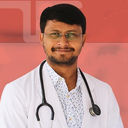
Dr. Ganeshgouda Majigoudra
Neurologist
10 Years • MBBS, MD ( GENERAL MEDICINE) DM (NEUROLOGY)
Bengaluru
Apollo Clinic, JP nagar, Bengaluru

Dr. E Prabhakar Sastry
General Physician/ Internal Medicine Specialist
40 Years • MD(Internal Medicine)
Manikonda Jagir
Apollo Clinic, Manikonda, Manikonda Jagir
(150+ Patients)
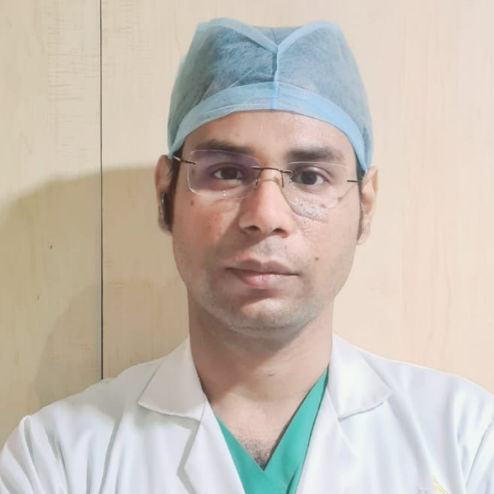
Dr Debnath Dwaipayan
Neurosurgeon
9 Years • MBBS, MS(Gen. Surgery), DrNB (Neurosurgery)
Delhi
Apollo Hospitals Indraprastha, Delhi
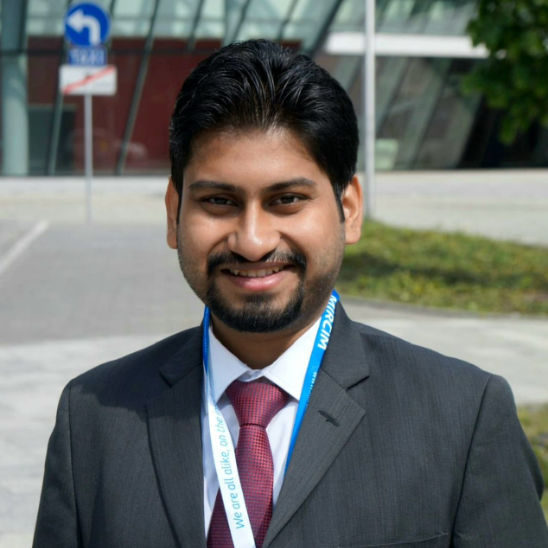
Dr. Uddalak Chakraborty
Neurologist
8 Years • MBBS, MD(GENL.MED.),DM(NEUROLOGY)
Kolkata
MCR SUPER SPECIALITY POLY CLINIC & PATHOLOGY, Kolkata
(25+ Patients)
Consult Top Specialists

Dr. Aditendraditya Singh Bhati
Neurosurgeon
21 Years • MBBS(2004), DNB Neurosurgery(2014); MNAMS; Fellow Skull Base Endoscopy (Italy), Fellow Extended Skull Base ( Weill Cornell, USA), Fellow ZAP-X Radiosurgery. Member of American Association of Neurological Surgeons
Delhi
Apollo Hospitals Indraprastha, Delhi
(100+ Patients)

Dr. Ganeshgouda Majigoudra
Neurologist
10 Years • MBBS, MD ( GENERAL MEDICINE) DM (NEUROLOGY)
Bengaluru
Apollo Clinic, JP nagar, Bengaluru

Dr. E Prabhakar Sastry
General Physician/ Internal Medicine Specialist
40 Years • MD(Internal Medicine)
Manikonda Jagir
Apollo Clinic, Manikonda, Manikonda Jagir
(150+ Patients)

Dr Debnath Dwaipayan
Neurosurgeon
9 Years • MBBS, MS(Gen. Surgery), DrNB (Neurosurgery)
Delhi
Apollo Hospitals Indraprastha, Delhi

Dr. Uddalak Chakraborty
Neurologist
8 Years • MBBS, MD(GENL.MED.),DM(NEUROLOGY)
Kolkata
MCR SUPER SPECIALITY POLY CLINIC & PATHOLOGY, Kolkata
(25+ Patients)
Consult Top Specialists

Dr. Aditendraditya Singh Bhati
Neurosurgeon
21 Years • MBBS(2004), DNB Neurosurgery(2014); MNAMS; Fellow Skull Base Endoscopy (Italy), Fellow Extended Skull Base ( Weill Cornell, USA), Fellow ZAP-X Radiosurgery. Member of American Association of Neurological Surgeons
Delhi
Apollo Hospitals Indraprastha, Delhi
(100+ Patients)

Dr. Ganeshgouda Majigoudra
Neurologist
10 Years • MBBS, MD ( GENERAL MEDICINE) DM (NEUROLOGY)
Bengaluru
Apollo Clinic, JP nagar, Bengaluru

Dr. E Prabhakar Sastry
General Physician/ Internal Medicine Specialist
40 Years • MD(Internal Medicine)
Manikonda Jagir
Apollo Clinic, Manikonda, Manikonda Jagir
(150+ Patients)

Dr Debnath Dwaipayan
Neurosurgeon
9 Years • MBBS, MS(Gen. Surgery), DrNB (Neurosurgery)
Delhi
Apollo Hospitals Indraprastha, Delhi

Dr. Uddalak Chakraborty
Neurologist
8 Years • MBBS, MD(GENL.MED.),DM(NEUROLOGY)
Kolkata
MCR SUPER SPECIALITY POLY CLINIC & PATHOLOGY, Kolkata
(25+ Patients)
More articles from Encephalopathy
Frequently Asked Questions
1) What are the earliest signs of acute encephalitis syndrome?
High fever with severe headache, vomiting, unusual sleepiness, or behaviour changes. Any confusion or seizure is a red flag—go to hospital immediately.
2) Is AES contagious?
Most causes of AES are not spread person-to-person. Many are mosquito-borne (like Japanese encephalitis) or related to other infections or toxins. Protect yourself with vaccination and mosquito control.
3) How is AES different from meningitis?
Meningitis is inflammation of the membranes around the brain and spinal cord; encephalitis involves brain tissue itself. Both can cause fever and severe headache, but confusion, seizures, and behaviour changes point more strongly to encephalitis. Doctors use CSF analysis and imaging to tell them apart.
4) Can lychee cause AES in children?
Lychee fruit itself isn’t universally dangerous. In specific contexts—undernourished children, evening consumption, skipped dinner—toxins in lychee can trigger nighttime hypoglycaemia and encephalopathy. Evening meals and rapid glucose in emergencies reduce risk.
5) When should I see a doctor after discharge?
Follow the schedule given by your hospital. If headaches, attention problems, or seizures persist beyond two weeks, consult a doctor online with Apollo 24|7 for further evaluation. For recommended follow-up labs, Apollo 24|7 offers home collection services.
